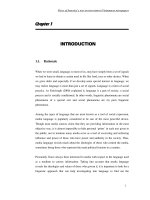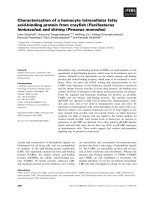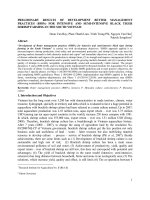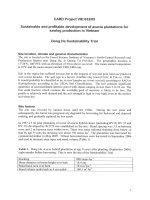domestication of black tiger shrimp (penaeus monodon) in recirculation systems in vietnam
Bạn đang xem bản rút gọn của tài liệu. Xem và tải ngay bản đầy đủ của tài liệu tại đây (627.89 KB, 199 trang )
Domestication of black tiger shrimp (Penaeus
monodon) in recirculation systems in Vietnam
Nguyen Duy Hoa
Promoter: Prof. dr. Patrick Sorgeloos
Department of Animal Production, Faculty of Bioscience
Engineering, Ghent University, Belgium.
Local promoter: Dr. Nguyen Van Hao
Research Institute for Aquaculture No.2, Ho Chi Minh City,
Vietnam.
Dean: Prof. dr. ir. Guido Van Huylenbroeck
Rector: Prof. dr. Paul Van Cauwenberge
Examination Committee and Reading Committee (*):
Prof. dr. ir. Herman Van Langenhove, Chairman, Department of Organic
Chemistry, Faculty of Bioscience Engineering, Ghent University, Belgium.
Prof. dr. Guy Smagghe, Secretary, Department of Crop Protection, Faculty of
Bioscience Engineering, Gent University, Belgium.
Prof. dr. Patrick Sorgeloos, Promoter, Department of Animal Production, Faculty
of Bioscience Engineering, Ghent University, Belgium.
Dr. Nguyen Van Hao, Local VLIR promoter, Research Institute for Aquaculture
No. 2, Ho Chi Minh City, Vietnam.
Prof. dr. ir. Peter Bossier, Department of Animal Production, Faculty of Bioscience
Engineering, Ghent University, Belgium.
*Prof. dr. Geert Janssens, Department of Animal Nutrition, Genetics, Breeding and
Ethology, Faculty of Veterinary Medicine, Ghent University, Belgium.
*Prof. dr. Lewis LeVay, University of Wales, Bangor, England.
*Dr. Roeland Wouters, INVE Technologies N.V., Dendermonde, Belgium.
Nguyen Duy Hoa
Domestication of black tiger shrimp (Penaeus
monodon) in recirculation systems in Vietnam
Thesis submitted in fulfilment of the requirements for the degree of
Doctor (PhD) in Applied Biological Sciences
Dutch translation of the title:
Domesticatie van de tijgergarnaal (Penaeus monodon) in
recirculatiesystemen in Vietnam
To cite this work:
Hoa, N.D., 2009. Domestication of black tiger shrimp (Penaeus
monodon) in recirculation systems in Vietnam. PhD thesis, Ghent
University, Belgium.
The author and the promoters give the authorisation to consult and to
copy parts of this work for personal use only. Every other use is subject
to the copyright laws. Permission to reproduce any material contained in
this work should be obtained from the author.
ISBN 978-90-5989-342-9
This study was funded by the Flemish Interuniversity Council (VLIR),
Belgium
ACKNOWLEDGEMENTS
First of all, I am very grateful to the Flemish Interuniversity Council (VLIR) for the
scholarship and research grant they provided to complete my PhD-research program.
Over more than four years, many people were involved in the research of this thesis,
all of them I would gratefully like to acknowledge here:
My deepest sincere gratitude is giving to my first promoter Prof. dr. Patrick Sorgeloos
for his enthusiastic guidance, encouragement, and persistent support over four years to
this PhD-research work. Patrick, behind the success of this thesis was your great
scientific and academic contribution. Your kind-hearted influence has brought people
together to help me finish this research work.
I also wish to thank Prof. dr. ir. Peter Bossier for his support to this research work.
Peter, although you may not have been directly involved in this research work, you
strongly welcomed me to do the PhD-research work at the Lab and always followed
the progress of my PhD-research work.
I am grateful to my local VLIR promoter, Dr. Nguyen Van Hao - director of the
Research Institute for Aquaculture No.2, for giving me the time to follow the PhD-
research work, for his guiding and contributing practical experiences in shrimp
farming and for providing facilities, staff and support for the experiments.
I am also grateful to Dr. Roeland Wouters; he has contributed significantly to the
research work on the section of broodstock shrimp nutrition as well as the review of
several papers. Roeland, without your help I could not have obtained good results on
experiments in this section as well as good quality domesticated breeders.
My special thanks go to Mathieu Wille, a very experienced direct supervisor and good
brother, friend. Mathieu, I never forget all what you have done for me You were
working hard together with me at the beginning to produce a quality proposal for
obtaining a scholarship and research grant. You were working hard to help me in
sample analysis, in discussion for experimental design, in correction and edition of
scientific papers as well as of this thesis.
Thanks a lot to Dr. Greg Coman from the Commonwealth Scientific and Industrial
Research Organization (CSIRO) in Australia who has contributed significantly to the
development of the sand-based recirculation system for our P. monodon
domestication program and also for his willingness to share the achieved knowledge
from his research program in Australia during my thesis experiments as well as to be
a co-author of one of my papers.
Special thanks to Magda Vanhooren, Marc Verschraeghen, Alex Pieters, Caroline
Van Geeteruyen and Dorinda Tack for their constant help in solving administrative
problems. Geert Vandewiele and Anita De Haese assisted with the analytical work.
Jean Dhont, Tom Baelemans, Jorg De Smyter were always willing to help me. To
Kristof Dierckens, Gilbert Van Stappen, Marijke Van Speybroeck, Brigitte Van
Moffaert, Christ Mahieu, Bart Van Delsen, Sebastian Vanopstal, and others, for their
friendship and assistance.
Thanks a lot many colleagues, Mr. Trinh Trung Phi, Mr. Vu Thanh, Mr. Nguyen
Quoc Hung, Mr. Tran Kim Dong, Mr. Nguyen Hong Bao Duy, Mr. Phan Anh Ha, Mr.
Dao Van Duoc, Mr. Ho Phat Cuong, Mrs. Le Dung Hoa, Mr. Hoang Thanh Lich, Mr.
Truong Thanh Tuan, Mr. Vo Quan Huy who contributed in one way or another in the
development of this domestication technique.
Many thanks to my friends and PhD colleagues, especially Dr. Nguyen Thi Ngoc
Tinh opened the information of the VLIR scholarship to the young generation at my
institute. I also wish to thank Dr. Le Hong Phuoc, Dr. Dang To Van Cam, Dr. Nguyen
Thi Ngoc Anh, Dr. Dinh The Nhan, Ho Manh Tuan, Nhu Van Can, Huynh Thanh Toi,
and others, for their support, friendship and making my life colourful during my stay
in Belgium.
Finally, I would like to dedicate this thesis to my wife and children, Le Thi Hang,
Nguyen Duy Hai and Nguyen Duy Hy, who have been patiently awaiting over 4 years
of my PhD-research work. My wife, Le Thi Hang, she has worked hard to take care of
our children and sacrificed to stand for lonely life during the time I have not been at
home. Behind the success of my PhD-research work as well as the success of my life
was always her silent sacrifices. Last but not least, great thanks to my parents, my
brothers and my sisters who always supported me and expected me to finish my PhD
degree. I know that words are not enough to express my gratitude to them…This
thesis is a present for them.
LIST OF ABBREVIATIONS
ANOVA Analysis of variance
ARA Arachidonic acid
CSIRO Commonwealth Scientific and Industrial Research Organization
DHA Docosahexaenoic acid
DW Dry weight
EFA Essential fatty acid
EPA Eicosapentaenoic acid
FAME Fatty acid methyl esters
FAO Food and agriculture organization
Fo: Wild origin generation
F1: First domesticated generation
F2: Second domesticated generation
HUFA Highly unsaturated fatty acid
ICP-PhD International Course Program-PhD
PCR Polymerase chain reaction
PGs Prostaglandins
PUFA Poly-unsaturated fatty acid
SEAFDEC Southeast Asian Fisheries Development Center
SPF Specific-pathogen-free
VASEP The Vietnam Association of Seafood Exporters and Producers
VLIR Vlaamse Interuniversitaire Raad (Flemish Inter-University Council)
TABLE OF CONTENTS
Chapter I. GENERAL INTRODUCTION 1
Chapter II. LITERATURE REVIEW 9
Domestication techniques for black tiger shrimp Penaeus monodon (Fabricius,
1798): a literature review. 11
Chapter III. REARING SYSTEM 35
Effect of water exchange, salinity regime, stocking density and diets on growth and
survival of domesticated black tiger shrimp Penaeus monodon (Fabricius, 1798)
reared in sand-based recirculating systems 37
Chapter IV. DOMESTICATION PROGRESS 55
Progress in the domestication of black tiger shrimp Penaeus monodon (Fabricius,
1798) in a sand-based recirculation system in Vietnam 57
Chapter V. BROODSTOCK NUTRITION 77
Section I. A fresh-food maturation diet with an adequate HUFA composition for
broodstock nutrition studies in black tiger shrimp Penaeus monodon (Fabricius,
1798) 79
Section II. Spawning performance and offspring quality of domesticated black
tiger shrimp Penaeus monodon fed a semi-moist maturation pellet 99
Chapter VI. GROW-OUT PERFORMANCE 119
Grow-out performance of domesticated Penaeus monodon (Fabricius, 1798) 121
Chapter VII. GENERAL DISCUSSION 129
Chapter VIII. REFERENCES 147
SUMMARY 169
CURRICULUM VITAE 181
Chapter I
1
CHAPTER I
GENERAL INTRODUCTION
General introduction
2
Chapter I
3
Chapter I
General introduction
The black tiger shrimp, Penaeus monodon Fabricius (1798), is one of the largest
penaeid shrimps in the world, reaching 270 mm in body length (Motoh, 1985), and is
of considerable commercial importance in international markets. P. monodon is
indigenous to Vietnam and has contributed significantly to the development of the
aquaculture sector and hence the economy, with a national production between
350,000-400,000 tons a year, recently. According to VASEP (Phi et al., 2009), shrimp
farming contributes around 40% in value of the total fisheries export turn-over of the
country. In 2007, the national shrimp production of approximately 350,000 tons, was
estimated to comprise of 270,000 tons of P. monodon and 80,000 tons of white
shrimp, Litopenaeus vannamei (Merican, 2008). According to Jeff Jie-Cheng Chuang,
Vice president of Uni-President Vietnam, the annual nationwide demand for
postlarvae is around 35 billion (Merican, 2008).
To date, shrimp hatcheries in Vietnam have been able to supply the demands of the
commercial shrimp farms, but prevalence of diseases and the low quality of the
postlarvae have resulted in huge damage to both the hatchery and grow-out sector.
Disease outbreaks, especially White Spot Syndrome Virus (WSSV), Yellow Head
Virus (YHV), Taura Syndrome Virus (TSV), Monodon BaculoVirus (MBV), etc. and
to a lesser extent, luminescent bacterial infections have resulted in a declining global
production in recent years for shrimp farmers in Asia and in the America and this
leads to an almost inevitable ‘boom-and-bust’ cycle of the shrimp farming industry
General introduction
4
(Flegel et al., 2004). Another factor contributing to the unstable development of the
shrimp farming industry is the reliance on wild shrimp broodstock for the hatchery
industry due to fluctuations in supply and declining natural stocks. The fishing of wild
broodstock poses serious problems to the natural resource and from an ecological
perspective, the fishing of wild stocks moreover is unacceptable in the long term. The
use of wild broodstock shrimp also poses serious risks for vertical disease
transmission from the breeders to the offspring, resulting in disease outbreaks and for
this reason, viral diseases must be controlled at the broodstock level itself (Craig,
1998; Yano, 2000; Arce, 2005; Coman et al., 2005).
Successful domestication of Penaeus monodon will ensure sufficient quantities of
good quality broodstock and consequently reliable offspring production. The
development of reliable domesticated stocks to produce high quality and SPF seed is
therefore imperative to a long-term sustainable development of P. monodon
aquaculture. With the goal of developing a successful domestication technique to
produce SPF domesticated P. monodon stock, this thesis aimed to: i) develop a sand-
based recirculation system for the indoor domestication of P. monodon, ii) develop a
protocol for each rearing phase of the domestication process in the developed
recirculation system; iii) develop suitable broodstock diets and feeding regimes to
improve reproductive performance, more specifically fecundity and egg hatching
success, of the domesticated P. monodon stock; and iv) evaluate the grow-out
performance of the offspring, produced from the domesticated stocks, at a commercial
farm environment. The overall goal of this study was to contribute to the sustainable
development of the P. monodon farming sector in Vietnam through development of
techniques that could lead to the commercialization of domesticated breeder stocks.
Chapter I
5
The thesis outline can be summarized as follows:
Chapter I (General introduction) draws an outline covering the main points of this
thesis.
Chapter II (Literature review) gives an overview of the development of P.
monodon domestication techniques during the last decades, focusing on techniques
how to close the life cycle of P. monodon in captivity, especially, nutritional and
environmental conditions and other zootechniques applied during the domestication
process. Environmental and seasonal factors, substrate, nutritional requirements,
genetic and male effects, as well as endocrinology, which are all known to affect the
quality of domesticated P. monodon broodstocks, are being discussed in this review.
Knowledge on reproductive biology and maturation of penaeid shrimp are also
reviewed in order to better understand the requirements for maturation and
reproduction of penaeid shrimp. Knowledge on shrimp nutrition, especially on P.
monodon and recent studies on broodstock nutrition of P. monodon investigating the
specific role of arachidonic acid in maturation, spawning and reproductive
performance are also reviewed and discussed in view of quality improvement of
domesticated P. monodon stocks.
Chapter III (Rearing system) reports on the development of a sand-based
recirculation system through different trials on water exchange regimes, rearing water
salinity, stocking density and diets for the grow-out phase of P. monodon.
Chapter IV (Domestication progress) developed a protocol for each phase of the
domestication process from eggs to breeders. The developed techniques focussed on
aspects of the rearing environment and diets for the 3 different rearing phases,
General introduction
6
including the grow-out phase (from 1 to 40g), the prematuration phase (from 40 to
80g), and the maturation phase (from 80 to larger than 100g). Performance was
evaluated in terms of growth, survival, spawning and reproductive performance.
Chapter V (Broodstock nutrition) consists of two parts:
Section I:
A fresh-food maturation diet with an adequate HUFA composition for broodstock
nutrition studies in black tiger shrimp Penaeus monodon (Fabricius, 1798). This
section reports on the development of a fresh-food maturation diet for improving the
reproduction of P. monodon and which could serve as a basic fresh-food maturation
diet for P. monodon maturation or as a control diet for further studies on artificial
maturation diets. The formulated fresh-food mixture was constructed based on the
ratios of ARA/EPA, DHA/EPA and ω3/ω6 fatty acids in mature ovaries of wild P.
monodon.
Section II:
Spawning performance and offspring quality of domesticated black tiger shrimp
Penaeus monodon fed a semi-moist maturation pellet. This section describes the
development of a feeding regime for optimising maturation and reproduction of P.
monodon in captivity by testing different substitution levels of the fresh-food
maturation diet (developed in section I) with a recently developed semi-moist
maturation diet (BREED-S FRESH®) (INVE Aquaculture N.V., Belgium).
Chapter I
7
In Chapter VI (Grow-out performance) grow-out performance of domesticated P.
monodon postlarvae at different commercial shrimp farms was evaluated and
compared with non-domesticated P. monodon stocks.
Chapter VII (General discussion) reiterates and discusses the overall results of the
experiments and the progress in domestication of P. monodon. Based on the
discussion, the general conclusions are drawn and prospective research topics are
proposed.
Chapter VIII (References) contains all the bibliographic citations mentioned in this
thesis.
General introduction
8
Chapter II
9
CHAPTER II
LITERATURE REVIEW
Literature review
10
Chapter II
11
Chapter II
Domestication techniques for black tiger shrimp Penaeus monodon
(Fabricius, 1798): a literature review.
Nguyen Duy Hoa
(1,3)
, Mathieu Wille
(3)
, Roeland Wouters
(2)
, Nguyen Van Hao
(1)
,
Patrick Sorgeloos
(3)
.
Research Institute for Aquaculture No.2, Ho Chi Minh City, Vietnam
(1)
.
INVE Technologies N.V., Dendermonde, Belgium
(2)
.
Laboratory of Aquaculture & Artemia Reference Center, Ghent university,
Belgium
(3)
.
Literature review
12
Abstract
Closing the life cycle of P. monodon in indoor rearing systems has recently been
successful with several generations being produced in research programs. However,
domesticated P. monodon stocks have not yet been commercialized mainly due to
poor reproductive performance, especially low natural mating, low fecundity and poor
egg hatching success. This paper summarizes present knowledge and current rearing
techniques used for domestication of P. monodon for production of specific-pathogen-
free domesticated stocks. Environmental and seasonal parameters, tank substrate,
nutritional requirements, genetic and male effects, and endocrinological factors are all
known to affect the quality of domesticated P. monodon broodstock and are therefore
being discussed in more detail. A number of selected P. monodon domestication
programs, especially those using indoor rearing systems, are reviewed. Overall rearing
techniques, nutritional and environmental conditions and other zootechniques applied
during the domestication process are discussed. Knowledge on reproductive biology
and maturation of penaeid shrimp is also discussed to elucidate the factors affecting
maturation and reproduction of penaeid shrimp. Knowledge on shrimp nutrition, with
special focus on P. monodon and recent studies on broodstock nutrition of P.
monodon investigating the specific roles of arachidonic acid in maturation, spawning
and reproductive performance of P. monodon are also reviewed and discussed.
Keywords: domestication, P. monodon.
1. Introduction
Worldwide expansion of the shrimp farming industry was attributed mostly the
success in the production of high quality nauplii through controlled maturation and









